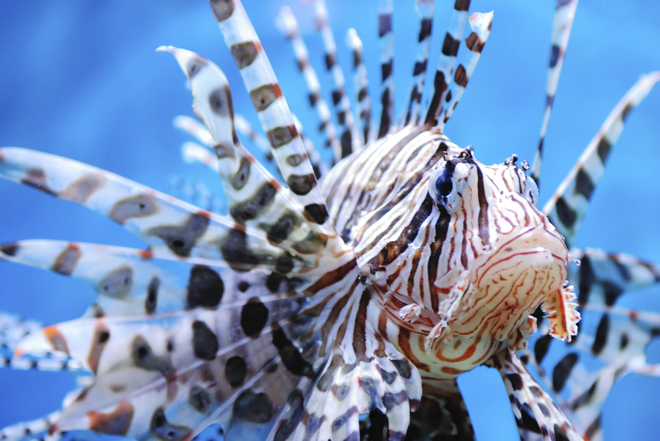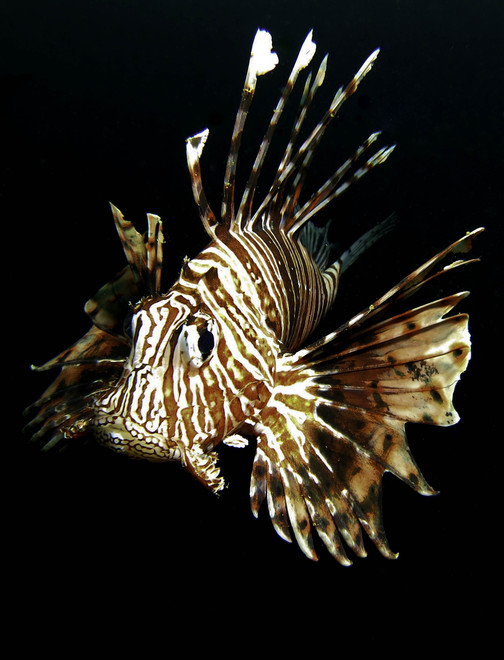Having never visited the Caribbean, I was used to visiting places where lionfish were a prize sighting on a dive — a fish appreciated for its beauty, and certainly not the subject of ceviche recipes and hunting expeditions. I’ve always had a soft spot for this photogenic species, and determined to find out why the Utila dive centers did not share my favorable opinion.

Further investigation introduced me to a problem most divers are by now familiar with, the so-called “Great Lionfish Invasion.” For the last twenty years, two of the world’s nine lionfish species have been building a formidable presence off the coast of the Eastern United States and in the tropical waters of the Caribbean. The red lionfish (Pterois voltans) accounts for 93 percent of the unwelcome visitors to these areas; the common lionfish (Pterois miles) makes up the last 7 percent..
Several theories abound as to how the lionfish first appeared in waters so far from their natural habitat in the Indo-Pacific. The most popular is that the destruction of a Florida aquarium by Hurricane Andrew in 1992 resulted in the release of captive lionfish into the ocean, however, there are reports that ecologist James Morris Jr. found a lionfish off the Florida coast in 1985, seven years before the hurricane. Since then, lionfish have been found, and continue to multiply, from the waters of Cape Hatteras in North Carolina to Belize, Honduras and Venezuela. It is now thought that the problem is exacerbated by the spread of lionfish larvae via ocean currents, as well as the transport of individuals in ship ballast water.
The lionfish is the perfect example of an invasive species, in its “capacity to dominate and negatively affect the foreign habitat in which it finds itself.” In their native Indo-Pacific, lionfish are not a threat to the environment because they have a natural place within it; they are part of the ecological balance. In the Western Atlantic and the Caribbean, however, lionfish lack natural predators to control their numbers, their voracious appetites and their aggressive behavior. Studies show that from 2004 to 2008, some of the affected areas have seen a 700 percent increase in lionfish numbers, and that their population densities are now greater in the Caribbean than in the areas from which they originated. It is thought that lionfish can cope with significant fluctuations in water temperature and salinity, further contributing to their success in new areas.

The introduction of lionfish to the Western Atlantic and the Caribbean, and their subsequent success in these environments, raises three main concerns. The first — and perhaps the most serious both in terms of long-term environmental damage and for us as divers — is the decline of native reef life as a result of lionfish predation. Lionfish are extremely capable predators, feeding mainly on other fish. Research carried out in small transects of Bahamian reef show that left unchecked, lionfish populations severely impacted the mortality rates for juveniles of other fish species, therefore negatively affecting reef biodiversity. Although there is still much research to be done, it is thought that if populations continue to grow, it could lead to local extinction of certain vulnerable or endemic species.
Secondly, there is a theory that the inability of the food chain to adapt to lionfish populations could cause declines of commercially viable fish, negatively affecting local fishing industries. While the basis for this concern is legitimate, there is too little scientific data as yet to confirm it as fact. Certainly the overfishing of grouper species in these areas is partly responsible for the ability of lionfish to flourish there in the first place, since there are very few natural predators left to keep their numbers under control.
The final concern is the correlative increase in lionfish with the number of human injuries caused by them. The beautiful fan-like fins, which make these fish so attractive, conceal venomous spines; contact can cause the release of harmful neurotoxins. Lionfish injuries require immediate and professional medical attention, and there is a concern (though currently unsubstantiated) that the increased presence of these fish in the Atlantic and Caribbean could put off potential tourists, also causing a loss of income to affected countries.
Although most authorities agree that lionfish cannot be completely eradicated from these ecosystems, efforts to keep their numbers under control are not only underway, but could also contribute to attracting dive tourism. Lionfish spawn monthly, and therefore actions to limit their numbers take the form of systematic and repeated eradication; visitors are often encouraged to get involved. This may seem distasteful, but frequent culls of these beautiful creatures are the only way to aid marine conservation on a greater scale.
In 2010, Florida Keys National Marine Sanctuary paved the way for this initiative by providing licences to kill lionfish within the perimeters of the protected area. Since then, the idea has caught on throughout the southern U.S. and the Caribbean, with conservation groups hosting lionfish hunting expeditions and divemasters carrying spear guns to shoot them while diving. There have been several efforts to introduce the idea of the lionfish as an edible delicacy — despite its venomous reputation, lionfish are reputedly tasty when properly prepared. Certainly the dive centers of Utila agree, where t-shirts explaining the correct procedure for cooking lionfish are sold by the dozen.
It will always be hard for me to perceive the lionfish as the enemy — spotting my first one off Mozambique was an unforgettable highlight of my early diving days. In their natural habitat lionfish are an important link in the marine ecosystem, but in the invaded areas of the US and Caribbean they have become a threat to the marine ecosystem.
Continued efforts to control their numbers are necessary to sustain the health of Mesoamerica reefs. Divers, scientists and conservationists must continue to work together to minimize the impact of invasive lionfish populations. We must also remember that human-caused problems like overfishing and pollution have far larger repercussions on the state of reefs worldwide, and in addressing the lionfish invasion we must not lose sight of the other threats to our oceans. It is unlikely that this problem would have occurred in the first place if not for human interference, and so the lionfish threat, though undoubtedly real, is only a small part of the greater struggle to preserve marine ecosystems worldwide.

